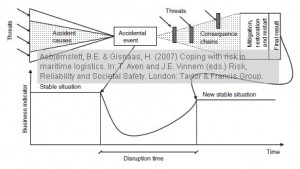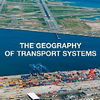 This week’s focus are risks in the maritime supply chain and today’s paper sets out a framework for risk, vulnerability and resilience in maritime supply chains. Coping with risk in maritime logistics, by Bjørn Egil Asbjørnslett and Hallvard Gisnaas, is a conference paper, presented at ESREL 2007, the European Safety and Reliability Conference, in Stavanger, Norway, 25-27 June 2007. Asbjørnslett is not a newcomer to this blog; I have previously reviewed some of his works on the vulnerability of production systems. He is also a proponent of supply chain risk and a member of ISCRIM, and it was while trying to find more of his publications that I stumbled upon the 2007 conference paper. The contents were both surprising and unsurprising.
This week’s focus are risks in the maritime supply chain and today’s paper sets out a framework for risk, vulnerability and resilience in maritime supply chains. Coping with risk in maritime logistics, by Bjørn Egil Asbjørnslett and Hallvard Gisnaas, is a conference paper, presented at ESREL 2007, the European Safety and Reliability Conference, in Stavanger, Norway, 25-27 June 2007. Asbjørnslett is not a newcomer to this blog; I have previously reviewed some of his works on the vulnerability of production systems. He is also a proponent of supply chain risk and a member of ISCRIM, and it was while trying to find more of his publications that I stumbled upon the 2007 conference paper. The contents were both surprising and unsurprising.
ESREL 2007
The purpose of the ESREL 2007 conference was to present a wide range of scientific papers covering both methods and applications in the fields of risk, safety and reliability. Special focus for the 2007 conference was new knowledge, theories and methodologies for the analysis and management of Risk, Reliability and Societal Safety. The papers from the conference were published in a 3-volume 3000-page monster proceedings titled Risk, Reliability and Societal Safety and it was here that I found today’s paper.
MARLOGRISK
Interestingly, Coping with risk in maritime logistics is not just the title of a paper, it is also the title of a 6-year research project under the acronym of MARLOGRISK: Managing risk, vulnerabilities and resilience in maritime logistics chains, a project that is almost worthy of a post itself on this blog. For now, suffice it to say that the objective of the project is to understand and manage the risks that origin when ship-owners or shipping agents extend their responsibility in cargo-owners’ value chains from not only port-to-port but also to door-to-door operations. And for the record, the second author of the paper, Hallvard Gisnaas, is a PhD-student with the project. The conference paper is a description of the research framework that is used within the MARLOGRISK project, and thus, todays “review” is perhaps more of a “project review” than a “literature review”.
Coping with risk in maritime logistics
Maritime logistics are the backbone of global supply chains, but unfortunately, risks in maritime supply chains are perhaps an underresearched area and consequently, the article outlines a rationale for why it is necessary to develop competence about risk, vulnerability and resilience management in maritime supply chains. The research questions are listed in the paper and on the MARLOGRISK website, but in essence:
How can we engineer resilience into the maritime logistics chain that meets the risk and vulnerability taxonomies of the context (i.e. the maritime logistics chain), and how can we analyze and manage the vulnerability and risk scenarios in a proactive manner?
The reason why risk and vulnerability, and resilience are more important in a sea-borne supply chain than in a land-borne chain is that the maritime chain has more interfaces between modes , and these interfaces represent potential weak points in the supply chain, as yesterday’s article on security risks in maritime supply chains has already pointed out. Moreover, many shipping companies accept responsibility not only for port-to-port (P2P) shipping, but also door-to-door (D2D), which extends not only the scope of the supply chain, but also the scope of risks and vulnerabilities this shipping company has to face.
How to analyze risk, vulnerability and resilience?
The focus of the vulnerability analysis is the short-term and long-term survivability of the system or the system mission, or in other words, the system’s resilience, as illustrated below:
Click image for larger version
By now this should be a well known figure for the readers of my blog, if you have read my previous posts on Asbjørnslett’s research. Even the vulnerability definition used 1o years ago in An Approach to Vulnerability Analysis of Complex Industrial Systems is still the same here. Nothing wrong with that, it is a good definition. Vulnerability is defined as
The properties of a logistics chain; its premises, facilities, handling and transportation equipment, inter- and intra-organisational construction, including contracts and incentives, human resources, human organisation and all its software, hardware, and netware, that may weaken or limit its ability to endure threats and survive accidental events that originate both within and outside the boundaries of the logistics chain.
Why is the vulnerability of maritime supply chains important?
Vulnerability may be used as a characteristic of a logistic system’s lack of robustness or resilience to withstand threats that originate within or outside the system’s boundaries. The vulnerability of a logistic system may be manifested both in the cargo dimension (through transport), its physical infrastructures, the information flows, as well as supporting services along the logistics chain. The focus of vulnerability is related to the logistic system’s mission as a provider of ‘repositioning’ services, adding time and place utility to products. Such services are a pre-requisite for the contemporary global production and manufacturing regime, consisting of tightly coupled production networks, with lean resource bases. Shipping and maritime logistics provide important logistics networks to enable this.
The key research question is how to engineer resilience into maritime logistics chains in general, given the different scope of different maritime logistics chains? That is achieved by applying the framework for categorizing supply chain risk and risk management used in Norrman & Lindroth (2004), but adapted to a maritime setting, as below:
Click image for larger version
This three-dimensional approach captures the different types of risks, the managerial context and the unit of analysis along three perpendicular axes. On the unit level, an input/output-model is used for going from the lowest level to the highest level (i.e. the full supply chain):
Click image for larger version
By the way, the input/output model already appears in Asbjørnslett and Rausand (1997) Assess the vulnerability of your production system.
Vulnerability, Risk and Resilience
The research project is grouped into six main topics:
- Resilient Global Maritime Logistics
- Risk and Vulnerability Taxonomies in Maritime Logistics
- Maritime Logistics Law
- Fleet and Chain Planning and Control under Uncertainty
- IT-based Vulnerability and Resilience in Maritime Logistics
- Vulnerability Analysis and Mitigation
In more detail:
Vulnerability and resilience of the global shipping system: The global shipping system is a prerequisite for global trading patterns. The focus in this topic is related to in which ways the global shipping systems are vulnerable, and with our ability to analyse the consequences for global trading patterns and the shipping industry of these vulnerabilities.
Risk and vulnerability taxonomies in maritime logistics: The point of departure for studies of risk, vulnerability or resilience is a structured overview and understanding of the sources and processes from and through which risks and vulnerabilities evolve.
Maritime logistics law: The focus is how the contract and the law or legal approach may act as an incentive mechanism to join up the interfaces in chain operations, rather than a mechanism that breaks up the interfaces of the chain.
Fleet and chain planning and optimisation under uncertainty: Fleet (e.g. vessel fleet) and chain planning are mostly conducted with predictable inputs. However, in real-life situations, uncertainty both as stochastic and dynamic influence will influence both planning and optimisation.
Vulnerability and resilience in logistics IT systems: The aim of this task is to address vulnerability following the use and dependability of IT systems in logistics chains, including security aspects, as well as looking at how such IT systems may contribute to resilient measures in logistics systems.
Vulnerability and mitigation analysis in maritime logistics: This task aims to develop methods and tools for vulnerability analysis of maritime logistics chains.
I find it interesting to note how the topics are group from a top level strategic and global perspective to the bottom level operations point of view.
Conclusion
This research project has barely started and even on the project website the list of publications is slight…so far. That said, this research is valuable, because it approaches risk management in the shipping and maritime logistics context from several points of view. It is fully in line with Peck (2006), who focuses on a multi-disciplinary approach for reconciling supply chain vulnerability, risk and supply chain management. I can only hope that this project achieves the objectives they set out to explore, and I can not help but smile at their last sentence:
We sail on, set to navigate challenging and rewarding waters.
I for one look forward to seeing where and if and how they reach the distant shores ahead.
Reference
Asbjørnslett, B.E. & Gisnaas, H. (2007) Coping with risk in maritime logistics. Paper presented at ESREL 2007, Stavanger, Norway, 25-27 June 2007. In: T. Aven and J.E. Vinnem (eds.) Risk, Reliability and Societal Safety. London: Taylor & Francis Group.
Author Links
- ntnu.no: Bjørn Egil Asbjørnslett
- ntnu.no: Hallvard Gisnaas
Link
- sintef.com: The MARLOGRISK project
Related
- husdal.com: Security in maritime supply chains
- husdal.com: The vulnerability of production system
- husdal.com: Vulnerability analysis of complex industrial systems
- husdal.com: Security risks in maritime supply chains















